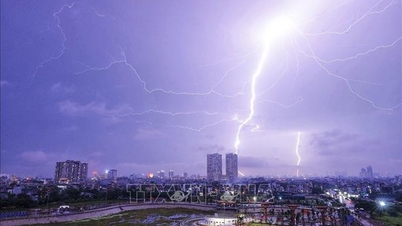
Lightning may not originate from what we once thought - Photo: AI
A groundbreaking new discovery in atmospheric physics suggests that lightning is not simply the result of ordinary thunderstorms. Instead, a powerful chain reaction, similar to a “pinball machine” effect, may be at work in the atmosphere, which could be the key to triggering lightning.
Although lightning is a familiar phenomenon, which can heat the air to up to 27,000 degrees Celsius, five times the temperature of the surface of the Sun, scientists have not yet fully understood its initiation process from within clouds.
In a new publication in the American Geophysical Union , an international research team led by Professor Victor Pasko and PhD student Zaid Pervez (Penn State University, USA) has for the first time provided a precise and quantitative explanation for this phenomenon.
"Our discovery provides the first clear, measurable explanation of how lightning starts in nature," Pasko said. "It connects elements from X-rays and electric fields to the physics of 'electron avalanches'."
According to the research team, the process of lightning initiation is similar to an invisible pinball machine inside a thundercloud. Specifically, the extremely strong electric fields in the thundercloud accelerate free electrons, causing them to collide violently with gas molecules such as nitrogen and oxygen.
These collisions produce X-rays and high-energy photons, which are the basic components of light. These photons then release new electrons through the photoelectric effect, creating a chain reaction known as a "relativistic electron avalanche".
When this process reaches a certain level, lightning is formed.
Not stopping at explaining ordinary lightning, the research team also expanded understanding of a more elusive phenomenon: "black lightning" or terrestrial gamma-ray flash.
These are high-energy X-ray bursts but are not accompanied by light or radio waves, which makes them nearly "invisible" to the naked eye and weather radar.
Based on detailed physical simulations, the team suggests that under the right conditions, the high-energy X-rays produced by electron avalanches can continue to create new electrons through the photoelectric effect in the air. This process occurs very quickly, forming a powerful self-amplifying chain reaction, but does not emit obvious light or a distinct radio signal.
This explains a phenomenon that has puzzled scientists for years: why some cloud regions, even though they appear very dark and calm, can produce high-energy gamma rays.
The discovery not only solves one of meteorology’s oldest mysteries, but also opens the door to important applications: more accurate lightning warnings in the future, a better understanding of the impact of lightning on aircraft and satellites, and further improvements in extreme weather forecasting models in the face of climate change.
Source: https://tuoitre.vn/cac-nha-khoa-hoc-giai-ma-bi-an-set-hinh-thanh-tu-may-20250730165942529.htm




![[Photo] Prime Minister Pham Minh Chinh receives the Chairman of the Japan-Vietnam Friendship Association in the Kansai region](https://vphoto.vietnam.vn/thumb/1200x675/vietnam/resource/IMAGE/2025/11/03/1762176259003_ndo_br_dsc-9224-jpg.webp)
![[Photo] General Secretary To Lam receives Singaporean Ambassador Jaya Ratnam](https://vphoto.vietnam.vn/thumb/1200x675/vietnam/resource/IMAGE/2025/11/03/1762171461424_a1-bnd-5309-9100-jpg.webp)
![[Photo] Fall Fair 2025 and impressive records](https://vphoto.vietnam.vn/thumb/1200x675/vietnam/resource/IMAGE/2025/11/03/1762180761230_ndo_br_tk-hcmt-15-jpg.webp)
![[Photo] Lam Dong: Close-up of illegal lake with broken wall](https://vphoto.vietnam.vn/thumb/1200x675/vietnam/resource/IMAGE/2025/11/03/1762166057849_a5018a8dcbd5478b1ec4-jpg.webp)








































































































Comment (0)